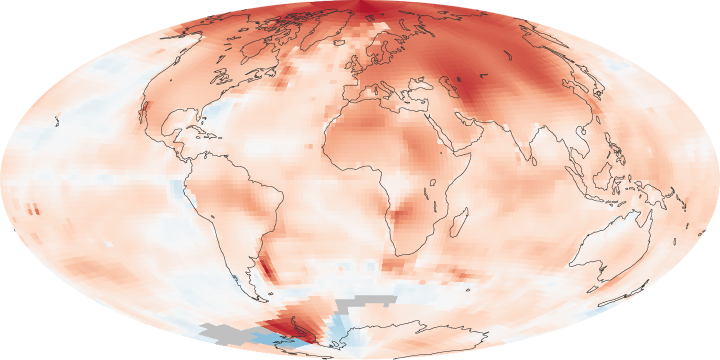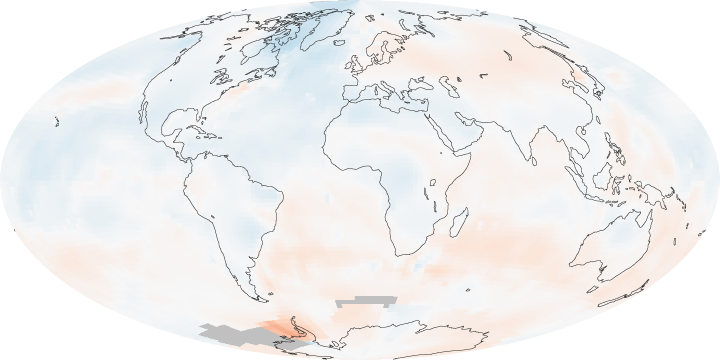NASA: The world is getting warmer
September 8th, 2019

January 1, 2000 – December 31, 2009


January 1, 1970 – December 31, 1979
The world is getting warmer. Whether the cause is human activity or natural variability, thermometer readings all around the world have risen steadily since the beginning of the Industrial Revolution.
According to an ongoing temperature analysis conducted by scientists at NASA’s Goddard Institute for Space Studies (GISS), the average global temperature on Earth has increased by about 0.8°Celsius (1.4°Fahrenheit) since 1880. Two-thirds of the warming has occurred since 1975, at a rate of roughly 0.15-0.20°C per decade.
The maps above show temperature anomalies, or changes, for 2000-2009 (top) and 1970-1979. The maps do not depict absolute temperature, but how much warmer or colder a region is compared to the norm for that same region from 1951-1980. That period was chosen largely because the U.S. National Weather Service uses a three-decade period to define “normal” or average temperature. The GISS temperature analysis effort began around 1980, so the most recent 30 years were 1951-1980. It is also a period when many of today’s adults grew up, so it is a common reference that many people can remember.
To conduct its analysis, GISS uses publicly available data from 6,300 meteorological stations around the world; ship-based and satellite observations of sea surface temperature; and Antarctic research station measurements. These three data sets are loaded into a computer analysis program—available for public download from the GISS web site—that calculates trends in temperature anomalies relative to the average temperature for the same month during 1951-1980.
The objective, according to GISS scientists, is to provide an estimate of temperature change that can be compared with predictions of global climate change in response to atmospheric carbon dioxide, aerosols, and changes in solar activity.
The temperatures we experience locally and in short periods can fluctuate significantly due to predictable cyclical events (night and day, summer and winter) and hard-to-predict wind and precipitation patterns. But the global temperature mainly depends on how much energy the planet receives from the Sun and how much it radiates back into space—quantities that change very little. The amount of energy emitted by the Earth depends significantly on the chemical composition of the atmosphere, particularly the amount of heat-trapping greenhouse gases.
Read more in World of Change: Global Temperatures.
NASA images by Robert Simmon, based on data from the Goddard Institute for Space Studies. Caption by Michael Carlowicz.
You can follow any responses to this entry through the RSS 2.0 feed. Both comments and pings are currently closed.
Comments are closed.
Categories
- 2019 Novel Coronavirus (100)
- Acute flaccid myelitis (AFM) (12)
- Air (1)
- Alkhurma hemorrhagic fever (AHF) (1)
- Aluminium phosphide (1)
- AMR-Antimicrobial Resistance (3)
- Anaplasmosis (3)
- Angiostrongylus cantonensis (4)
- Animals/Pets (13)
- Anthrax (20)
- Avalanche (16)
- Aviation (70)
- Bioterrorism (30)
- Blast Effects/Injuries (35)
- Botulism (32)
- Buruli ulcer (1)
- Cancer (6)
- Candida auris (9)
- CBIRNE (3)
- CCHF (2)
- CDC (111)
- Chagas Disease (8)
- Chemical Threats (43)
- Chikungunya (62)
- China (12)
- Cholera (83)
- Ciguatera (4)
- Civil unrest (38)
- Climate Change (64)
- CO (4)
- Coccidioidomycosis (1)
- Communicable diseases (7)
- Conflict (117)
- Cyanide (2)
- Cyberterrorism (6)
- Cyclospora (5)
- Dengue (50)
- Diarrhea (5)
- Diphtheria (6)
- Documents (96)
- Drills/exercises (24)
- Drought (9)
- E. coli O157:H7 (5)
- Earthquake (213)
- Eastern Equine Encephalitis (1)
- Ebola (171)
- Echovirus 30 (1)
- Education (17)
- Elephantiasis (lymphatic filariasis (2)
- EMS (7)
- Environment (33)
- Ethics (5)
- Europe (6)
- Explosives (47)
- Famine (12)
- FBI (7)
- FCC (1)
- FDA (16)
- FEMA (45)
- FGM (Female Genital Mutilation) (15)
- Filariasis (2)
- Fires/Wildfires (251)
- First Responders (22)
- Flood (161)
- Folic Acid (1)
- Food-borne diseases (104)
- Global Health (129)
- Guinea worm disease/Dracunculiasis (9)
- H3N2 (3)
- H5N6 (1)
- H7N9 (50)
- H9N2 (1)
- Haff Disease (1)
- Hajj (1)
- Hanta virus (1)
- Hazardous Materials (HAZMAT) (84)
- Hepatitis C (16)
- Historical (382)
- Historical Event (397)
- HIV/AIDS (10)
- Homeland Security (7)
- Hookworm (1)
- Human Rights (26)
- Humanitarian (107)
- Influenza (136)
- Kids-Infants (112)
- Konzo (2)
- Landslides/mudslides (22)
- Lassa Fever (31)
- Lead poisoning (2)
- Legionnaire's Disease (6)
- Leishmaniasis (10)
- Leprosy (5)
- Leptospirosis (4)
- Lightning (3)
- Listeria (6)
- Loiasis (1)
- Malaria (55)
- Malnutrition (6)
- Maritime (58)
- Mass fatalities (69)
- Mass Gatherings (19)
- Mass shooting (197)
- Mayaro fever (1)
- MCI (4)
- Measles (49)
- Melioidosis (6)
- Meningitis (9)
- Mental health (11)
- MERS-CoV (157)
- Microplastics (1)
- Migration (128)
- Monkeypox (6)
- Mumps (3)
- Mycetoma (1)
- Naegleria fowleri (9)
- NASA (28)
- NDMS/DMAT (2)
- Neglected Tropical Diseases (15)
- Neurocysticercosis (1)
- Nipah virus (11)
- NOAA (2)
- Nodding Syndrome (1)
- Non-communicable diseases (3)
- Norovirus (1)
- Novichok (12)
- Ntwetwe virus (1)
- Nuclear-Radiation-Contamination (70)
- Obesity (2)
- Onchocerciasis (river blindness) (3)
- ORT (1)
- Pandemic (93)
- PFAs (1)
- PHEMCE (3)
- Plague (40)
- Podoconiosis (2)
- PODs (2)
- Polio (33)
- Pollution (10)
- Public Health (25)
- Rabies (35)
- Red Cross/Red Crescent (9)
- Ricin (8)
- Rift Valley Fever (5)
- Riots (15)
- Rocky Mountain Spotted Fever (2)
- Rohingya (63)
- Rotavirus (2)
- Salmonella (4)
- Salt (1)
- Schistosomiasis (5)
- Scurvy (1)
- Seoul Virus (1)
- SFTS (9)
- Silicosis (1)
- Slavery (6)
- Smallpox (10)
- Smog (6)
- Snake envenomation (7)
- Social media (2)
- Stampede (17)
- STI (1)
- Strategic National Stockpile (9)
- Structural (71)
- Sword's Point (1)
- TB (8)
- Telemedicine (1)
- Terrorism (443)
- Tetanus (4)
- Thelaziasis (2)
- Tick-borne diseases (1)
- Tobacco (3)
- Tornado (33)
- Trachoma (10)
- Trafficking (11)
- Transportation incident (103)
- Trauma (5)
- Triage (2)
- Trichinosis (1)
- Tropical cyclones (470)
- Tropical storms (336)
- Tsunami (22)
- Tuberculosis (12)
- Tularemia (2)
- Typhoid fever (2)
- Uncategorized (103)
- United Nations (14)
- USDA (3)
- Usutu virus (1)
- VHF (10)
- Vibrio vulnificus (2)
- Volcano (82)
- Water (28)
- Weather (186)
- West Nile Virus (11)
- WHO (124)
- Women issues (37)
- Wuhan (55)
- Yellow Fever (86)
- Zika virus (271)
Recent Posts
Archives
- February 2022
- December 2021
- May 2021
- April 2021
- March 2021
- February 2021
- January 2021
- December 2020
- November 2020
- October 2020
- September 2020
- August 2020
- July 2020
- June 2020
- March 2020
- February 2020
- January 2020
- December 2019
- November 2019
- October 2019
- September 2019
- August 2019
- July 2019
- June 2019
- May 2019
- April 2019
- March 2019
- February 2019
- January 2019
- December 2018
- November 2018
- October 2018
- September 2018
- August 2018
- July 2018
- June 2018
- May 2018
- April 2018
- March 2018
- February 2018
- January 2018
- December 2017
- November 2017
- October 2017
- September 2017
- August 2017
- July 2017
- June 2017
- May 2017
- April 2017
- March 2017
- February 2017
- January 2017
- December 2016
- November 2016
- October 2016
- September 2016
- August 2016
- July 2016
- June 2016
- May 2016
- April 2016
- March 2016
- February 2016
- January 2016
- December 2015
- November 2015

